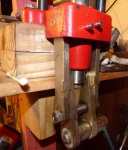Insert a case into the shellholder, lower the handle. Pick up a new piece of brass, smear Imperial on it, raise the handle, remove the old piece, insert the new piece, lower the handle. Repeat. I use it because it helps to reduce variation and the technique delivers consistent timing.
I ran tests with 10 pieces of LC LR brass and Lapua brass. Evaluation by measuring shoulder datum with RCBS Precision Mic.
1. as above
2. lube the case, insert into press, cycle the handle, next case.
3. same as option 2 only double pump
I do not cam-over. I do not use an expander button. I do expand with a mandrel; when expanding I use graphite in the neck. Variation: try with annealed and not-annealed cases.
Option 1 produced less variation than option 2. Option 1 was typically +- .001 (frequently less), option 2 was typically +- .002 - .003 with a few cases up to .005. Annealing helped to reduce variation in both options. Option 3 was similar to option 1. Results same for both brass types.
YMMV.


